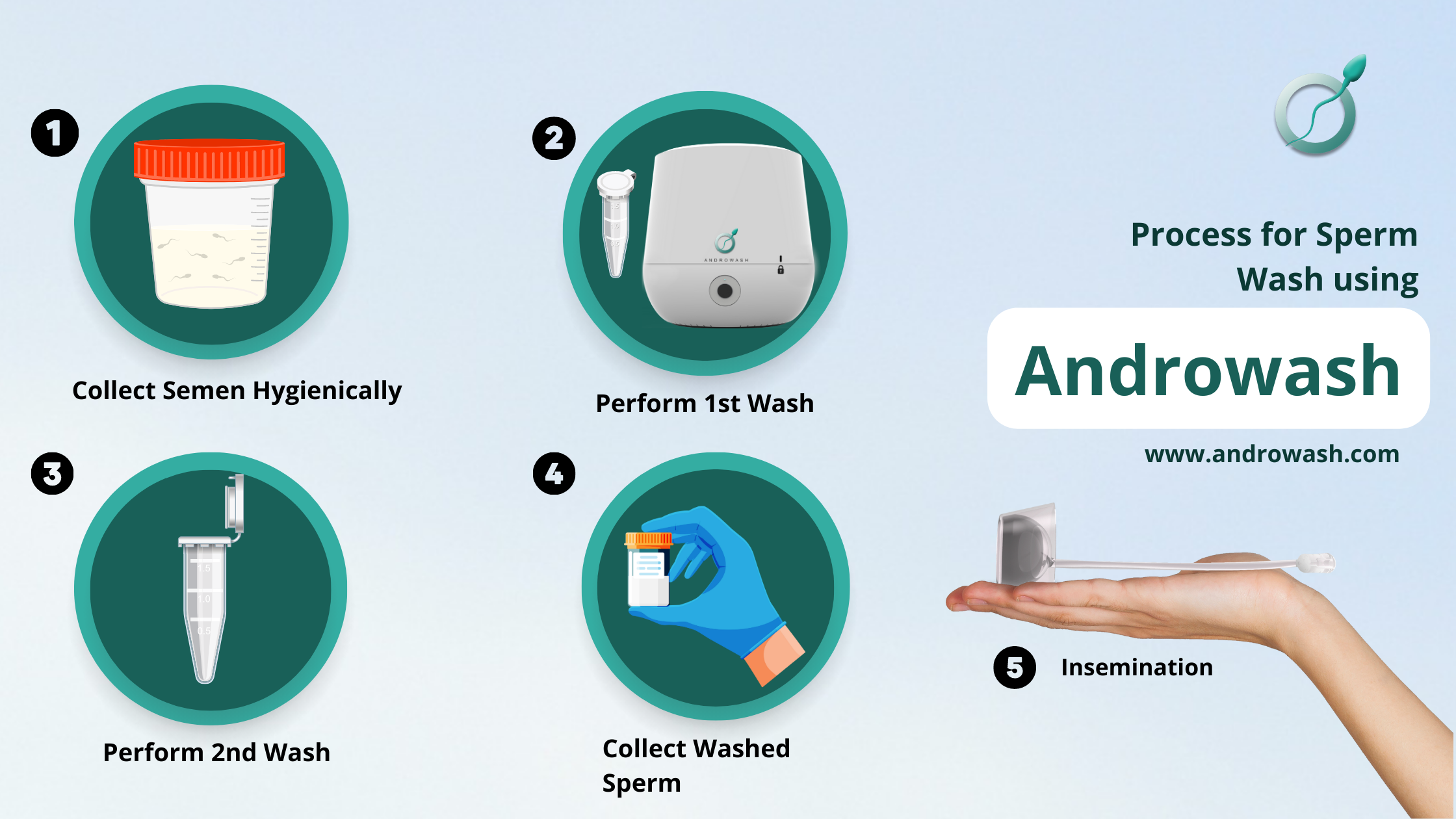What is sperm washing and how is it done?
Sperm washing is a technique used to separate healthy sperm from semen for use in intrauterine insemination (IUI). It involves spinning the semen sample in a centrifuge to separate motile sperm from seminal fluid and other substances, ensuring only the most viable sperm are used for fertilization.
Key Highlights
- Sperm washing is crucial step in fertility, particularly intrauterine inse (IUI).
- Sperm washing involves a semen sample and separating healthy sperm from the fluid and other debris- The Androw method is a revolutionary approach sperm preparation forUI.
- Androw works by enhancing the and quantity of the sample, increasing the chances successful fertilization.
IUI is a fertility treatment that involves washed and concentrated sperm directly the uterus during ov.
- Sperm and IUI together provide a synergistic effect, improving the success rates of conception.
Introduction
Intrauterinemination (IUI) is a type of fertility that helps couples or individuals conceive by placing washed and concentrated sperm directly inside the uterus during ovulation.
This procedure bypasses the natural journey of sperm from the vagina to the fallopian tubes, increasing the chances of successful fertilization. To ensure the best possible outcomes, sperm washing is an essential step in the IUI process.
Sperm washing involves collecting a semen sample and separating the healthy sperm from the seminal fluid and other debris.
The process aims to remove chemicals, bacteria, and viruses that may interfere with fertilization. By isolating the healthy sperm, their motility and viability are enhanced, increasing the likelihood of successful fertilization.
The Androwash method has revolutionized sperm washing for IUI. Developed as an advanced sperm preparation technique, Androwash improves the quality and quantity of the sperm sample.
This method ensures that only high-quality sperm are used for the insemination procedure, optimizing the chances of conception.
Understanding Sperm Washing and Its Importance in Fertility Treatments
Sperm washing plays a crucial role in various fertility treatments, including intrauterine insemination (IUI). It is particularly important when dealing with low sperm count or using donor sperm.
By separating the healthy sperm from the seminal fluid and other debris, sperm washing ensures that only the best quality sperm are used for fertilization.
This significantly increases the chances of conception, making it an essential step in fertility treatments.
What is Sperm Washing?
Sperm washing is a process that involves collecting a semen sample and separating the healthy sperm from the seminal fluid. The semen sample is collected through ejaculation and then undergoes a series of steps to isolate the healthy sperm.
These steps typically include dilution, centrifugation, and sometimes the addition of a density gradient medium. The aim is to remove debris, chemicals, bacteria, viruses, and non-viable sperm from the sample.
The final result is a concentrated sample of high-quality, healthy sperm that is ready for use in fertility treatments such as intrauterine insemination (IUI). Sperm washing is a crucial step in fertility treatments as it ensures that only the best sperm are used for fertilization, increasing the chances of successful conception.
The Role of Sperm Washing in Enhancing Fertility
Sperm washing plays a vital role in enhancing fertility, especially in cases of low sperm count or impaired sperm quality. By separating the healthy sperm from the seminal fluid and other debris, sperm washing ensures that only the best quality sperm are used for fertilization. This significantly increases the chances of successful conception.
Sperm washing is particularly important in fertility treatments such as intrauterine insemination (IUI), where the washed and concentrated sperm is placed directly into the uterus during ovulation.
By using the highest quality sperm, the likelihood of successful fertilization and pregnancy is greatly improved. Sperm washing is a crucial step in fertility treatments, optimizing the chances of conception for couples or individuals struggling with infertility.
The Androwash Method: A Revolutionary Approach to Sperm Preparation
The Androwash method is a revolutionary approach to sperm preparation for fertility treatments such as artificial insemination and in vitro fertilization (IVF). Developed as an advanced technique, Androwash improves the quality and quantity of the sperm sample, increasing the chances of successful fertilization.
By isolating the healthy sperm and removing the debris and unwanted substances from the sample, Androwash ensures that only the highest quality sperm are used for the fertility treatment.
This method has significantly improved the outcomes of artificial insemination and IVF, providing hope for couples struggling with infertility.
How Androwash Works for Sperm Washing
Androwash works by enhancing the quality and quantity of the sperm sample for fertility treatments. The process begins by collecting the semen sample, which is then subjected to a series of steps to isolate the healthy sperm.
Androwash utilizes advanced techniques to remove debris, chemicals, bacteria, viruses, and non-viable sperm from the sample.
By isolating the high-quality sperm, Androwash ensures that only the best sperm are used for fertilization.
This significantly increases the chances of successful conception. Additionally, Androwash improves the sperm’s ability to navigate through the cervical mucus, enhancing their journey towards the egg during the fertility treatment.
Comparing Androwash with Traditional Sperm Washing Techniques
When comparing Androwash with traditional sperm washing techniques, several differences become apparent. Androwash utilizes advanced methods to isolate the healthy sperm from the seminal fluid and other debris, ensuring the highest quality sperm for fertilization.
Traditional techniques, on the other hand, may not be as effective in achieving the same level of sperm quality. Additionally, Androwash improves the sperm’s ability to navigate through the cervical mucus and reach the fallopian tubes, increasing the chances of successful fertilization.
This makes Androwash an ideal choice for fertility treatments such as intrauterine insemination (IUI), where the washed and concentrated sperm is directly placed into the uterus during ovulation.
The Intrauterine Insemination (IUI) Process Simplified
Intrauterine insemination (IUI) is a fertility treatment that involves placing washed and concentrated sperm directly into the uterus during ovulation.
The procedure is relatively simple and minimally invasive, often taking place at a doctor’s office. A thin tube called a catheter is used to insert the sperm into the uterus.
IUI, also known as donor insemination, is often recommended for couples struggling with mild endometriosis or other fertility issues.
By bypassing the natural journey of sperm through the cervix and into the uterus, IUI increases the chances of successful fertilization. The simplified process of IUI makes it a popular choice for couples or individuals seeking fertility treatment.
Step-by-Step Guide to the IUI Procedure
The IUI procedure involves several steps to ensure the best possible outcomes. The process begins with a thorough examination, including semen analysis, ultrasound, and other diagnostics.
This helps determine the optimal timing for the procedure, which should ideally be during your time of ovulation. If necessary, fertility drugs may be prescribed to stimulate egg production.
Once the eggs are mature, a semen sample is collected and washed to isolate the healthy sperm. The washed sperm is then placed directly into the uterus using a thin tube called a catheter.
After the procedure, the patient may be asked to lie down for a short period. A pregnancy test can be taken approximately two weeks after the IUI. It is important to note that there is a risk of ovarian hyperstimulation syndrome (OHSS) with fertility drugs, but this is rare.
Preparing for Your IUI: Tips and Recommendations
Preparing for an IUI procedure requires careful planning and preparation. Here are some tips and recommendations to ensure the best possible outcomes:
- Keep track of your menstrual cycle to determine the optimal timing for the IUI procedure.
- Follow your doctor’s instructions regarding fertility drugs, if prescribed, to stimulate egg production.
- Avoid sexual intercourse for a few days leading up to the IUI procedure to ensure an optimal sperm sample.
- Maintain a healthy lifestyle, including a balanced diet and regular exercise, to optimize fertility.
- Stay hydrated and avoid excessive caffeine and alcohol consumption, as they can impact fertility.
The Synergy Between Sperm Washing and IUI
The combination of sperm washing and intrauterine insemination (IUI) creates a synergistic effect, significantly improving the success rates of conception.
Sperm washing ensures that only the highest quality sperm are used for fertilization, increasing the chances of successful conception. When combined with IUI, which places the washed and concentrated sperm directly into the uterus during ovulation, the probability of successful fertilization is further enhanced.
Additionally, fertility drugs may be used to stimulate egg production, further boosting the success rates of the fertility treatment. The synergy between sperm washing and IUI provides hope for couples struggling with infertility.
How Sperm Washing Improves the Success Rates of IUI
Sperm washing plays a crucial role in improving the success rates of intrauterine insemination (IUI). By isolating the healthy sperm and removing debris and non-viable sperm, sperm washing ensures that only the highest quality sperm are used for fertilization.
This significantly increases the chances of successful conception during the IUI procedure. Additionally, sperm washing improves the sperm’s ability to navigate through the cervical mucus and reach the fallopian tubes, where fertilization occurs.
This enhances the overall success rates of IUI. After the procedure, it is recommended to take a pregnancy test approximately two weeks later to determine the outcome. Mild cramping may be experienced after the IUI procedure, which is a normal symptom.
Ideal Candidates for Sperm Washing Before IUI
Sperm washing before intrauterine insemination (IUI) is recommended for various individuals and couples struggling with infertility. Ideal candidates for sperm washing before IUI include those with low sperm count or other sperm impairments, as well as individuals using donor sperm.
Additionally, couples experiencing cervical mucus problems or other issues with the cervix can benefit from sperm washing before IUI. Fertility drugs may be prescribed to ensure proper ovulation timing, making individuals taking fertility medication also ideal candidates for sperm washing before IUI.
Men with male infertility issues such as erectile dysfunction, low sperm quality, ejaculation issues, and other sperm impairments, including semen allergy, can also benefit from sperm washing before IUI. Sperm washing optimizes the quality and viability of the sperm sample, increasing the chances of successful fertilization during the IUI procedure.
Benefits of Choosing Sperm Washing with Androwash for IUI
Choosing sperm washing with Androwash for intrauterine insemination (IUI) offers several benefits. Androwash, as an advanced sperm preparation method, ensures that only the highest quality sperm are used for fertilization, increasing the chances of successful conception.
This is particularly beneficial for individuals or couples using donor sperm, as it allows for the best possible selection of sperm from a sperm bank. By utilizing the advanced techniques of Androwash, the success rates of IUI are significantly improved, providing hope for those struggling with infertility.
Sperm washing with Androwash offers a reliable and effective solution for individuals and couples seeking fertility treatment.
Increased Chances of Conception
Intrauterine insemination (IUI) is a fertility treatment that can significantly increase the chances of pregnancy. During a natural conception, only a small percentage of sperm from the seminal fluid are able to reach the fallopian tubes where fertilization occurs.
However, with IUI, the sperm is washed and concentrated, ensuring that only high-quality sperm from your partner’s sperm or donor sperm are used for the procedure, thus increasing the chances of pregnancy.
By placing the concentrated sperm directly into the uterus, IUI reduces the time and distance the sperm has to travel to reach the egg. This increases the likelihood of successful fertilization.
Additionally, IUI can be performed during a woman’s natural cycle, without the need for fertility drugs, making it a more natural and less invasive option for conception.
Overall, IUI offers couples and individuals a higher chance of achieving pregnancy compared to natural conception alone.
Safety and Efficacy of the Androwash Method
The Androwash method is a commonly used technique for sperm washing in the process of intrauterine insemination (IUI). It is a safe and effective method that helps improve the chances of successful fertilization for couples with male factor infertility.
During the Androwash method, the sperm sample is collected and then washed using a flexible tube.
The washing process removes any debris or non-motile sperm, leaving behind only the highest quality and motile sperm. These healthy sperm are then concentrated and prepared for insemination.
The Androwash method ensures that only the healthiest and most viable sperm are used for IUI, increasing the chances of successful fertilization and pregnancy. It is a widely used technique in fertility clinics and has been proven to be both safe and effective in helping couples overcome male factor infertility.
Addressing Common Concerns: Risks and Side Effects
When considering any fertility treatment, it is important to address common concerns regarding risks and side effects. While intrauterine insemination (IUI) is generally a safe procedure, there are some potential risks and side effects to be aware of.
Unlike more invasive fertility treatments like in vitro fertilization (IVF), IUI does not involve the use of fertility medicines or invasive procedures.
This reduces the risk of complications associated with these treatments. However, there is a small risk of infection, spotting, and ovarian hyperstimulation syndrome (OHSS) with IUI.
It is important to discuss these potential risks and side effects with your healthcare provider before undergoing IUI. They can provide you with detailed information and guidance on how to manage and minimize any potential risks.
Potential Risks Associated with Sperm Washing and IUI
Sperm washing and intrauterine insemination (IUI) are generally safe procedures with minimal risks. However, it is important to be aware of the potential risks associated with these processes.
One potential risk is the risk of infection. Although rare, there is a small chance of developing an infection after the sperm washing and IUI procedure.
It is important to follow the guidelines provided by your fertility clinic and take any prescribed antibiotics to minimize this risk.
Another potential risk is ovarian hyperstimulation syndrome (OHSS). This condition can occur when the ovaries are overstimulated by fertility medications, such as human chorionic gonadotropin (hCG).
OHSS can cause the ovaries to become painful and swollen. Your healthcare provider will closely monitor your response to fertility medications to minimize the risk of OHSS.
It is important to discuss any concerns or questions about the potential risks associated with sperm washing and IUI with your healthcare provider. They can provide you with personalized information and guidance based on your specific situation.
Managing Side Effects and Ensuring Safety
While intrauterine insemination (IUI) is generally a safe procedure, there may be some side effects that you may experience. It is important to know how to manage these side effects and ensure your safety during the process.
One common side effect of IUI is mild cramping. This is a normal response to the procedure and usually subsides within a few hours. Over-the-counter pain relievers can help alleviate any discomfort.
Some women may also experience spotting or light bleeding after IUI. This is also normal and should resolve on its own within a few days.
To ensure your safety during the IUI procedure, it is important to choose a reputable fertility clinic that follows strict protocols and guidelines. The exam table should be clean and sterile, and the healthcare provider should use sterile instruments and wear gloves to minimize the risk of infection.
By following these guidelines and managing any side effects that may arise, you can ensure a safe and successful IUI procedure.
Evaluating Success: What to Expect After IUI with Sperm Washing
After undergoing intrauterine insemination (IUI) with sperm washing, it is important to understand what to expect in terms of success rates and potential outcomes. The success of IUI can vary depending on various factors, including the underlying cause of infertility and the number of cycles of IUI performed.
Typically, it is recommended to undergo multiple cycles of IUI to increase the chances of success. The success rates of IUI range from 10-20% per cycle, with higher success rates seen with multiple cycles and timely treatment, especially for those with advanced maternal age.
However, it is important to note that undergoing multiple cycles also carries a higher risk of multiple births, which can lead to premature labor and low birth weight. It is important to discuss the potential success rates and risks of IUI with your healthcare provider to determine the best course of action for your specific situation.
Understanding the Success Rates of IUI with Sperm Washing
The success rates of intrauterine insemination (IUI) with sperm washing can vary depending on several factors. One important factor is the cause of infertility. IUI is most successful for couples with unexplained infertility or mild male factor infertility.
The success rates can also be influenced by the use of fertility medications such as clomiphene citrate. These medications help stimulate ovulation and increase the chances of successful fertilization during the IUI procedure.
On average, the success rates for IUI range from 10-20% per cycle. However, it is important to note that success rates can vary depending on individual circumstances.
Your healthcare provider can provide you with personalized information regarding the expected success rates for your specific situation.
It is also important to keep in mind that IUI may not be successful for everyone. If multiple cycles of IUI have been unsuccessful, it may be worth considering other fertility treatment options such as in vitro fertilization (IVF).
When to Consider Further Fertility Treatment Options
If you have undergone multiple cycles of intrauterine insemination (IUI) with sperm washing without success, it may be necessary to consider further fertility treatment options. The decision to pursue additional treatments will depend on various factors, including the cause of infertility, age, and test results.
If the underlying cause of infertility is known and IUI has not been successful, your healthcare provider may recommend more advanced treatments such as in vitro fertilization (IVF).
IVF involves fertilizing the egg with sperm in a laboratory setting and then transferring the resulting embryo into the uterus.
It is also important to consider the male partner’s fertility status when deciding on further treatment options. If there are severe sperm abnormalities or low sperm count, IVF with intracytoplasmic sperm injection (ICSI) may be recommended.
Ultimately, the decision to pursue further fertility treatment options should be made in consultation with your healthcare provider. They will be able to provide you with personalized recommendations based on your specific situation.
Recommended lifestyle changes before and after IUI with sperm washing
Before undergoing intrauterine insemination (IUI) with sperm washing, there are certain lifestyle changes that can improve your chances of success. These include:
- Eating a healthy and balanced diet rich in fruits, vegetables, whole grains, and lean proteins
- Maintaining a healthy weight as both underweight and overweight can affect fertility
- Avoiding smoking, alcohol, and recreational drug use as they can negatively impact fertility
- Managing stress through relaxation techniques such as yoga, meditation, or counseling
- Avoiding excessive caffeine consumption as it may affect fertility
After IUI, it is important to continue these lifestyle changes to support a healthy pregnancy. Additionally, your healthcare provider may recommend:
- Taking prenatal vitamins to ensure adequate nutrition for both you and the developing fetus
- Avoiding strenuous exercise or activities that may put stress on the reproductive organs
- Maintaining regular follow-up appointments with your healthcare provider to monitor the progress of your pregnancy
Conclusion
Sperm washing is a crucial step in fertility treatments, especially in enhancing the success rates of Intrauterine Insemination (IUI).
The Androwash method has revolutionized sperm preparation, offering increased chances of conception and maintaining safety and efficacy. By understanding the synergy between sperm washing and IUI, ideal candidates can optimize their fertility journey.
Despite potential risks and side effects, managing them ensures a safe procedure. Evaluating success post-IUI with sperm washing sets expectations and guides further fertility treatment decisions.
For more in-depth information on combining sperm washing with other fertility treatments and lifestyle changes pre and post-IUI, explore our detailed blog.
Frequently Asked Questions
Can Sperm Washing be Combined with Other Fertility Treatments?
Yes, sperm washing can be combined with other fertility treatments such as in vitro fertilization (IVF). In IVF, the sperm and egg are fertilized outside the body and then implanted into the uterus. Sperm washing ensures that only high-quality sperm cells are used in the IVF process. The National Infertility Association provides more information on the different fertility treatment options available.
How Many IUI Attempts Should Be Made Before Exploring Other Options?
Most healthcare providers recommend trying at least three cycles of intrauterine insemination (IUI) before exploring other fertility treatment options. This allows for multiple attempts to increase the chances of successful conception. If IUI is not successful after three cycles, your healthcare provider may recommend other options such as in vitro fertilization (IVF). It is best to discuss your specific situation with your doctor’s office and have regular transvaginal ultrasounds to monitor the progress of the treatment.
What is the process of sperm washing in intrauterine insemination (IUI)?
Sperm washing is an essential step in the process of intrauterine insemination (IUI). It involves collecting a semen sample and removing any debris or non-motile sperm. The remaining healthy and motile sperm are then concentrated and prepared for insemination. This process ensures that only the best sperm are used for IUI, increasing the chances of successful fertilization and pregnancy. The success of IUI depends on the quality and motility of the sperm, as well as the timing of the procedure in relation to ovulation and the travel of sperm to the egg.
Are there any risks or side effects associated with sperm washing and IUI?
While sperm washing and intrauterine insemination (IUI) are generally safe procedures, there are some potential risks and side effects to consider. These can include a small risk of infection, spotting or light bleeding, and the rare possibility of ovarian hyperstimulation syndrome (OHSS). Additionally, some individuals may have a rare allergy to their partner’s semen, which can cause discomfort and irritation. It is important to discuss any concerns or potential allergies with your healthcare provider. It is also crucial to ensure that the timing of the procedure is appropriate, aligning with the right time in your menstrual cycle for optimal chances of success.




